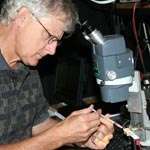Research lights up biochip potential

New research from a University of Alberta optics expert is shining a light on some of the challenges facing lab-on-a-chip technology. Electrical engineering professor Dr. Jim McMullin has developed a new type of biochip, which may eliminate the need for the bulky technology to analyze the results of tests happening within the tiny channels of biochips.
Biochips, made by the same processes as microchips in electronic devices, are the basic elements of a new technology designed to carry out diagnostic testing normally done on a large scale in labs. Lab-on-a-chip technology, as it's been called, promises greater efficiency in medical testing - producing information about a patient's cellular health and genetics quickly and inexpensively, speeding up patient diagnosis and treatment.
But while the technology is promising, it needs some fine-tuning before commercialization can become a reality. And that's where McMullin's work comes in. His hybrid, multi-layer, silicon/glass chip contains an integrated optics system that may eliminate the need for bulky lenses to illuminate parts of the chip for analysis.
"What we're trying to do is take the chip and, instead of using a microscope, use integrated waveguides to guide the light into the channels, into the exact spots you want to look at, and to do that in a very inexpensive way, say for a few hundred dollars instead of a hundred thousand dollars," said McMullin, whose research is published in the most recent edition of the Journal of Micromechanics and Microengineering.
"The idea of putting micro-optics inside the chip is to be able to deliver light to - or collect light from - multiple locations simultaneously. Light can be launched into the optical waveguides at the chip edge, and guided to precise location."
In the multi-level biochip, these waveguides appear as hollow, metallized grooves in a silicon wafer, and transfer light to the channels in the glass layer. The light is needed for scientists to detect biological cells in the chip, or to obtain chemical, genetic or proteomic information from extremely small samples.
This technology not only promises to make lab-on-a-chip technology sleeker, but could help pave the way for further developments in efficiency.
"One of the goals of our research is, instead of having a chip with one channel, you might have, say, 10 channels, and you bring light into all of those channels and they're all operating simultaneously on the same chip."
Currently, biochips generally contain one channel, and cannot conduct many tests at once.
"My main interest is in making these more functional chips, with wave guides and channels out of different materials, so that one chip could be used for multiple tests before being disposed of."
McMullin is also exploring ways to make biochips capable of sorting cells, something that could be particularly helpful with cancer screening.
"If you had a small number of cells, and someone wanted to do a test looking for pre-cancerous cells for example, someone could take a biopsy, load it onto a chip, and the chip would pick out the cells that were the most likely candidates to be pre-cancerous, and then you could study those," he said.
"Instead of having a laboratory technician staring through a microscope all day trying to decide, 'That one looks abnormal, let's pull that one out.'"
McMullin is specifically examining fluorescence-activated cell sorting, which detects and sorts cells by shining a laser on particles chemically treated to fluoresce.
"People have done it on chips, but it's all very rudimentary still. Most of this stuff is still in its early days. There are no standards - it's good stuff for an academic because we can explore all possible options without restrictions."
Source: By Caitlin Crawshaw, University of Alberta





















